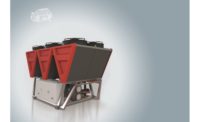To mitigate the worst effects of climate change, we must cut global carbon emissions 43% from 2019 levels by 2030 — a deadline that is less than seven years away. To meet this imperative, all sectors of the economy are moving on a path toward decarbonization. Some sectors, like commercial buildings, have opportunities to make a bigger impact than others.
Buildings account for nearly 40% of global greenhouse gas emissions — 75% of which result from daily operations. HVAC is a major contributor to commercial building energy use, and many experts point to HVAC efficiency and electrification as a vital factor for achieving sustainability. Heat pumps are recognized as key technologies that unite these pillars of decarbonization.
By shifting from on-site fossil fuel combustion to the superior efficiency of electric heat pumps, heating systems can utilize increasingly low-carbon electricity to significantly reduce carbon emissions. As they decarbonize buildings, heat pumps can also help building owners and facility managers meet corporate decarbonization goals and government regulations. Innovations in heat pump technology are expanding the breadth of applications for a wider range of climates, while incentives are increasing overall adoption.
MEETING EMISSIONS BENCHMARKS AND ENERGY EFFICIENCY REGULATIONS
Many building owners and operators are tasked with achieving greenhouse gas (GHG) emission reductions by meeting benchmarks established through corporate sustainability initiatives. In parallel, federal, state, and local policymakers have also recognized the need to address the built environment in their climate policies. Opportunities presented by HVAC efficiency and electrification can help achieve their goals, and, in many cases, these initiatives have become mandatory requirements.
For example, implementation of the U.S. Department of Energy (DOE) 2023 energy conservation standards for commercial unitary air conditioners and heat pumps has raised energy efficiency requirements by some 20% since 2015. The government is on the cusp of raising these standards again. Recent updates to model building energy codes, which include the 2024 International Energy Conservation Code and ASHRAE Standard 90.1, push building system efficiencies for new construction. Locally, these policies include mandatory building performance standards (BPS)i that will drive retrofits of existing buildings to meet today’s energy efficiency standards.
The World Economic Forum estimates that 80% of buildings that exist today will still be in use as the world approaches the net zero goal posts in 2050, making building retrofits crucial to meeting this ambitious goal. Although there is not currently a nationally mandated BPS requirement, the National BPS Coalition has engaged several federal agencies, including the DOE and the Environmental Protection Agency (EPA), to mobilize adoption of these standards in key cities throughout the country by Earth Day 2024. Whether these BPSs are based on site energy use, source energy use or carbon emissions per square foot, heat pumps and other high-efficiency HVAC systems can play a huge role in helping building owners meet these new requirements.
Many building owners and facility managers are deploying energy-efficient heat pumps and advanced controls to meet GHG emissions benchmarks and new regulations, but they’re seeing other benefits, too. Not only do heat pumps reduce carbon emissions, but they also help organizations reduce operational costs by cutting on-site heating energy consumption by as much as two-thirds.
While most buildings can be at least partially electrified with a heat pump, many heat pump applications are installed with a backup heat source to maintain heating capacity during the coldest periods of the year. This backup heating source can be fuel combustion or electric-resistance heating. Using fuel combustion as the backup source can reduce source emissions and peak demand on the electric grid by eliminating the use of inefficient electric resistance during critical heating periods. The latest innovations in heat pump technology are improving heat pump performance in cold temperatures, further minimizing the use of backup heating sources.
ADVANCING HEAT PUMP TECHNOLOGY
Older air-source heat pump systems were primarily viewed as an option for cooling, providing heating only at moderate outdoor temperatures, thus limiting use in warmer climates. And in buildings with hydronic systems, they were rarely considered at all. Today’s high-efficiency heat pumps are engineered to provide reliable space heating in colder climates and can be retrofitted into buildings with steam or hot water distribution systems. This technological evolution has been driven by several impressive innovations, including:
- Advancements in compressor technology, including variable-speed scroll, screw, and centrifugal compressors. Variable-speed scroll compressors are now used within air-source heat pump systems, significantly improving performance at low ambient conditions.
- Applied air-to-water and water-to-water heat pumps, which provide heating and cooling, and thus a new approach to traditional boiler and chiller designs.
- Ground-source and water-source heat pumps with two compressors in series, which can deliver hot water temperatures as high as 176◦ F, making them viable boiler replacements. For industrial-scale heat pumps, temperatures can reach more than 190◦ F.
Air-to-water and water-to-water heat pumps have been intentionally designed to make a greater range of commercial buildings, from offices to hospitals to schools, more sustainable. These heat pumps feature energy-efficient technology, such as electronic vapor injection (EVI) compressors, while using refrigerants with low global warming potential (GWP). When delivering heating and cooling simultaneously, these heat pumps can be five times more efficient than a boiler-chiller combination. Depending on the size of the building, multiple chiller types can be combined to meet the required load and performance.
Beyond improving energy efficiency, water-to-water heat pumps can reduce water consumption, too, by minimizing the need for cooling towers.
Smarter controls can further maximize heat pump efficiency and performance, and are vital for strategic building energy management. Today, many building systems contain some level of remote monitoring and/or automation. These can be powerful features in managing individual loads, but they often lack a holistic view into contextual, full-building performance. Optimization of system- and component-level assets to achieve building- and portfolio-level outcomes are critical to achieving sustainability goals, like maintaining energy efficiency in response to shifting internal and external factors.
And that’s just the start. Some enterprise management solutions take building optimization a step further by integrating a data-informed algorithm and presenting building managers with ideal operational sequences. Sustainability services can weave in GHG emissions tracking and enable building owners to set, track and optimize for achievement of decarbonization targets at the building and portfolio levels. As these digital solutions evolve and “learn” from an expanding data set of building performance, they’ll drive deeper user insights and enable increasingly beneficial outcomes.
DRIVING ADOPTION THROUGH INCENTIVES
The initial cost of advanced HVAC equipment is often the biggest hurdle for building professionals managing capital investments. However, new financing models and a broad array of federal, state, and local incentives are making heat pumps and other decarbonization options ever affordable. For example, a few companies offer energy efficiency and decarbonization as a service, which can enable capital upgrades such as heat pumps to be taken off of a property owner’s balance sheet and packaged with a service agreement for which they make monthly payments for the solution. These monthly payments can be smaller than the savings delivered by the project, and in some cases are even guaranteed.
Additionally, federal incentive programs such as the 179D tax deduction — significantly expanded by the passage of the Inflation Reduction Act (IRA) — can provide tax savings equivalent to up to $5 per square foot based on qualifying efficiency standards and net efficiency increases.
At the local level, commercial property-assessed clean energy (CPACE) loans provide an opportunity to offset these upfront costs. The CPACE loan structure enables building owners to borrow money for energy efficiency projects and make repayments via an assessment on their property tax bill. CPACE loans are offered through state and local programs and have been expanded n some cases as a method to support building performance standards implementation.
Finally, many utilities offer incentives as part of the state policies to meet energy efficiency targets and, in some cases, GHG reduction targets. For example, the state of Massachusetts established mandatory GHG reductions to be achieved through utility programs, and, as a result, programs through MassSave are expected to heavily incentivize heat pump systems.
Climate policies and incentive program implementation will vary from state to state and city to city, so programs can look very different depending upon the building location.
In addition to incentives, return on investment is vital to making these system upgrades for many building owners and operators. In fact, the 2021 Johnson Controls Energy Efficiency Indicator Survey found that 85% of those surveyed expressed energy cost-savings as the top driver for investing in sustainability.ii
DECARBONIZING BUILDINGS THROUGH CONTINUOUS INNOVATION
Decarbonization of the commercial building sector will require a combination of energy efficiency, electrification and digitalization strategies. Today’s advanced heat pumps encompass each of these factors to support an achievable path to sustainability. iii
As market and regulatory drivers continue to increase demand for heat pumps, contractors should expect to see an increasing breadth of heat pump options and performance for a wider range of commercial buildings, especially in colder climates. As digitalization provides more practical, data-informed insights, new opportunities will become available to deliver comprehensive services remotely, through features like automated fault detection and diagnostics. That’s why, through continuous innovation in heat pump and related technologies and services like these, the commercial building sector is poised to take bold strides on its path to decarbonization.
[i] National BPS Coalition, “About the National BPS Coalition” (No date)
[ii] World Economic Forum, “To Create Net-Zero Cities, We Need To Look Hard at Our Older Buildings” (November 2022)
[iii] Johnson Controls, “2021 Energy Efficiency Indicator Survey” (April 2021)








